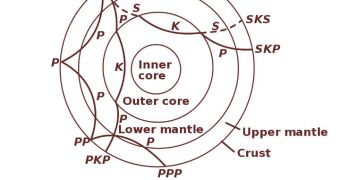A team of researchers has produced a new method of analyzing the inner parts of the plant using seismic waves, in an approach similar to creating a seismological CAT scan. This could help shed more light on the behavior of volcanoes, and on the phenomena underlying earthquakes.
Geologists are very excited about the new system, as it could finally grant them access into parts of the planet's mantle that have thus far eluded thorough studies.
Experts behind this new seismic wave technology hope to eventually be able to create a complete map of the mantle, including its movement patterns and other behaviors.
The mantle is arguably one of the most important traits Earth has. It underlies volcanic activity and the generation of tsunamis, and determines the location of continents on the planet's surface at all times.
It also plays a critical role in recycling the crust, the hard rock layer on which all continents and oceans lie. The mantle also breaks apart tectonic plates, forcing them to collide with each other.
Understanding it could therefore further knowledge in all these other fields of research, which would help planetary scientists get a better understanding on how our planet functions.
“We hope to create a traffic map of where the freeways and the junctions of the mantle are,” explains University of Bristol geophysicist and study team member Andy Nowacki, quoted by LiveScience.
The mantle is very peculiar because, even though it's made of solid rocks, it flows around like a viscous liquid. Heat coming from the planetary nucleus creates convection currents, that continuously stir it up.
But knowledge of the mantle is limited to its upper regions. Studies have been unable to penetrate down to its deepest layers, where it meets up with Earth's core.
Finding out how the two interact could be used to determine in more details how the planetary surface will change over millions of years.
“It's not going to help us predict volcanoes in Indonesia, but in a much bigger sense, if we understand the heat flow out of the Earth and the structure of the mantle and the core in a longer sense, we'll understand plate tectonics better,” explains Michael Bergman.
The expert is based at the Bard College in Simon's Rock, Massachusetts. He was not involved int eh research, but wrote an accompanying commentary in the latest issue of the esteemed journal Nature.
He explains that the Earth's interior can be analyzed by tracking down the seismic waves that are formed when a large earthquake strikes. These readings allow experts access to depths reaching the planetary core.
These waves hit various structures within the mantle, and get reflected in all directions. Specialized networks can pick these variations, and researchers can then determine the inner structure of the planet.

 14 DAY TRIAL //
14 DAY TRIAL //